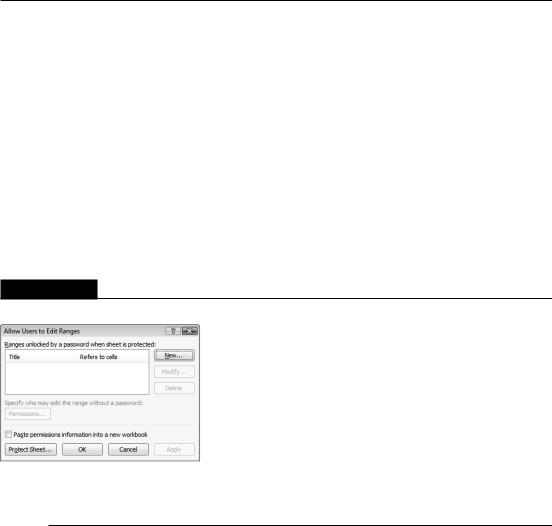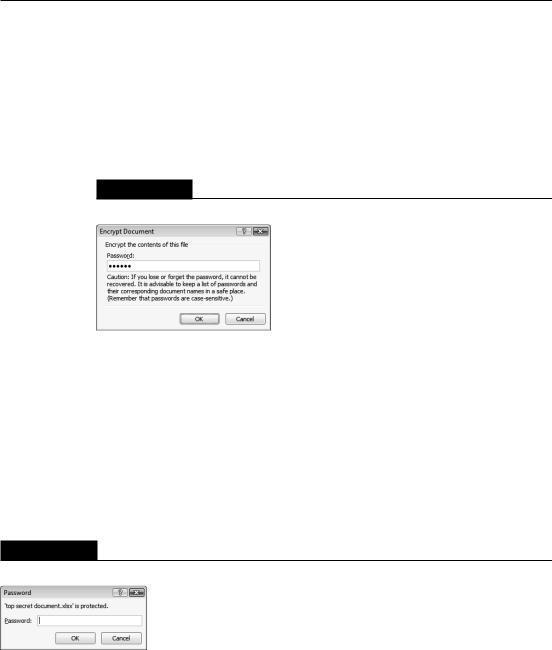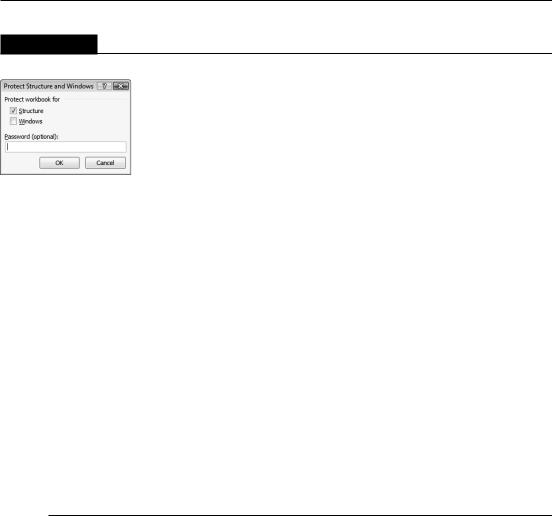
- •About the Author
- •About the Technical Editor
- •Credits
- •Is This Book for You?
- •Software Versions
- •Conventions This Book Uses
- •What the Icons Mean
- •How This Book Is Organized
- •How to Use This Book
- •What’s on the Companion CD
- •What Is Excel Good For?
- •What’s New in Excel 2010?
- •Moving around a Worksheet
- •Introducing the Ribbon
- •Using Shortcut Menus
- •Customizing Your Quick Access Toolbar
- •Working with Dialog Boxes
- •Using the Task Pane
- •Creating Your First Excel Worksheet
- •Entering Text and Values into Your Worksheets
- •Entering Dates and Times into Your Worksheets
- •Modifying Cell Contents
- •Applying Number Formatting
- •Controlling the Worksheet View
- •Working with Rows and Columns
- •Understanding Cells and Ranges
- •Copying or Moving Ranges
- •Using Names to Work with Ranges
- •Adding Comments to Cells
- •What Is a Table?
- •Creating a Table
- •Changing the Look of a Table
- •Working with Tables
- •Getting to Know the Formatting Tools
- •Changing Text Alignment
- •Using Colors and Shading
- •Adding Borders and Lines
- •Adding a Background Image to a Worksheet
- •Using Named Styles for Easier Formatting
- •Understanding Document Themes
- •Creating a New Workbook
- •Opening an Existing Workbook
- •Saving a Workbook
- •Using AutoRecover
- •Specifying a Password
- •Organizing Your Files
- •Other Workbook Info Options
- •Closing Workbooks
- •Safeguarding Your Work
- •Excel File Compatibility
- •Exploring Excel Templates
- •Understanding Custom Excel Templates
- •Printing with One Click
- •Changing Your Page View
- •Adjusting Common Page Setup Settings
- •Adding a Header or Footer to Your Reports
- •Copying Page Setup Settings across Sheets
- •Preventing Certain Cells from Being Printed
- •Preventing Objects from Being Printed
- •Creating Custom Views of Your Worksheet
- •Understanding Formula Basics
- •Entering Formulas into Your Worksheets
- •Editing Formulas
- •Using Cell References in Formulas
- •Using Formulas in Tables
- •Correcting Common Formula Errors
- •Using Advanced Naming Techniques
- •Tips for Working with Formulas
- •A Few Words about Text
- •Text Functions
- •Advanced Text Formulas
- •Date-Related Worksheet Functions
- •Time-Related Functions
- •Basic Counting Formulas
- •Advanced Counting Formulas
- •Summing Formulas
- •Conditional Sums Using a Single Criterion
- •Conditional Sums Using Multiple Criteria
- •Introducing Lookup Formulas
- •Functions Relevant to Lookups
- •Basic Lookup Formulas
- •Specialized Lookup Formulas
- •The Time Value of Money
- •Loan Calculations
- •Investment Calculations
- •Depreciation Calculations
- •Understanding Array Formulas
- •Understanding the Dimensions of an Array
- •Naming Array Constants
- •Working with Array Formulas
- •Using Multicell Array Formulas
- •Using Single-Cell Array Formulas
- •Working with Multicell Array Formulas
- •What Is a Chart?
- •Understanding How Excel Handles Charts
- •Creating a Chart
- •Working with Charts
- •Understanding Chart Types
- •Learning More
- •Selecting Chart Elements
- •User Interface Choices for Modifying Chart Elements
- •Modifying the Chart Area
- •Modifying the Plot Area
- •Working with Chart Titles
- •Working with a Legend
- •Working with Gridlines
- •Modifying the Axes
- •Working with Data Series
- •Creating Chart Templates
- •Learning Some Chart-Making Tricks
- •About Conditional Formatting
- •Specifying Conditional Formatting
- •Conditional Formats That Use Graphics
- •Creating Formula-Based Rules
- •Working with Conditional Formats
- •Sparkline Types
- •Creating Sparklines
- •Customizing Sparklines
- •Specifying a Date Axis
- •Auto-Updating Sparklines
- •Displaying a Sparkline for a Dynamic Range
- •Using Shapes
- •Using SmartArt
- •Using WordArt
- •Working with Other Graphic Types
- •Using the Equation Editor
- •Customizing the Ribbon
- •About Number Formatting
- •Creating a Custom Number Format
- •Custom Number Format Examples
- •About Data Validation
- •Specifying Validation Criteria
- •Types of Validation Criteria You Can Apply
- •Creating a Drop-Down List
- •Using Formulas for Data Validation Rules
- •Understanding Cell References
- •Data Validation Formula Examples
- •Introducing Worksheet Outlines
- •Creating an Outline
- •Working with Outlines
- •Linking Workbooks
- •Creating External Reference Formulas
- •Working with External Reference Formulas
- •Consolidating Worksheets
- •Understanding the Different Web Formats
- •Opening an HTML File
- •Working with Hyperlinks
- •Using Web Queries
- •Other Internet-Related Features
- •Copying and Pasting
- •Copying from Excel to Word
- •Embedding Objects in a Worksheet
- •Using Excel on a Network
- •Understanding File Reservations
- •Sharing Workbooks
- •Tracking Workbook Changes
- •Types of Protection
- •Protecting a Worksheet
- •Protecting a Workbook
- •VB Project Protection
- •Related Topics
- •Using Excel Auditing Tools
- •Searching and Replacing
- •Spell Checking Your Worksheets
- •Using AutoCorrect
- •Understanding External Database Files
- •Importing Access Tables
- •Retrieving Data with Query: An Example
- •Working with Data Returned by Query
- •Using Query without the Wizard
- •Learning More about Query
- •About Pivot Tables
- •Creating a Pivot Table
- •More Pivot Table Examples
- •Learning More
- •Working with Non-Numeric Data
- •Grouping Pivot Table Items
- •Creating a Frequency Distribution
- •Filtering Pivot Tables with Slicers
- •Referencing Cells within a Pivot Table
- •Creating Pivot Charts
- •Another Pivot Table Example
- •Producing a Report with a Pivot Table
- •A What-If Example
- •Types of What-If Analyses
- •Manual What-If Analysis
- •Creating Data Tables
- •Using Scenario Manager
- •What-If Analysis, in Reverse
- •Single-Cell Goal Seeking
- •Introducing Solver
- •Solver Examples
- •Installing the Analysis ToolPak Add-in
- •Using the Analysis Tools
- •Introducing the Analysis ToolPak Tools
- •Introducing VBA Macros
- •Displaying the Developer Tab
- •About Macro Security
- •Saving Workbooks That Contain Macros
- •Two Types of VBA Macros
- •Creating VBA Macros
- •Learning More
- •Overview of VBA Functions
- •An Introductory Example
- •About Function Procedures
- •Executing Function Procedures
- •Function Procedure Arguments
- •Debugging Custom Functions
- •Inserting Custom Functions
- •Learning More
- •Why Create UserForms?
- •UserForm Alternatives
- •Creating UserForms: An Overview
- •A UserForm Example
- •Another UserForm Example
- •More on Creating UserForms
- •Learning More
- •Why Use Controls on a Worksheet?
- •Using Controls
- •Reviewing the Available ActiveX Controls
- •Understanding Events
- •Entering Event-Handler VBA Code
- •Using Workbook-Level Events
- •Working with Worksheet Events
- •Using Non-Object Events
- •Working with Ranges
- •Working with Workbooks
- •Working with Charts
- •VBA Speed Tips
- •What Is an Add-In?
- •Working with Add-Ins
- •Why Create Add-Ins?
- •Creating Add-Ins
- •An Add-In Example
- •System Requirements
- •Using the CD
- •What’s on the CD
- •Troubleshooting
- •The Excel Help System
- •Microsoft Technical Support
- •Internet Newsgroups
- •Internet Web sites
- •End-User License Agreement

Chapter 31: Protecting Your Work
Assigning user permissions
Excel also offers the ability to assign user-level permissions to different areas on a protected worksheet. You can specify which users can edit a particular range while the worksheet is protected. As an option, you can require a password to make changes.
This feature is rarely used, and the setup procedure is rather complicated. But if you need this level of protection, setting it up might be worth the effort.
1.Unprotect the worksheet if it’s protected.
2.Choose Review Changes Allow Users to Edit Ranges. The dialog box shown in Figure 31.4 opens.
3.Follow the prompts in the series of dialog boxes that follow.
4.Protect the sheet.
FIGURE 31.4
The Allow Users to Edit Ranges dialog box.
Protecting a Workbook
Excel provides three ways to protect a workbook:
•Require a password to open the workbook.
•Prevent users from adding sheets, deleting sheets, hiding sheets, and unhiding sheets.
•Prevent users from changing the size or position of windows.
I discuss each of these methods in the sections that follow.
Requiring a password to open a workbook
Excel lets you save a workbook with a password. After doing so, whoever tries to open the workbook must enter the password.
641

Part IV: Using Advanced Excel Features
To add a password to a workbook, follow these steps:
1.Choose File Info Protect Workbook Encrypt With Password. Excel displays the Encrypt Document dialog box shown in Figure 31.5.
2.Type a password and click OK.
3.Type the password again and click OK.
4.Save the workbook.
FIGURE 31.5
Specify a workbook password in the Encrypt Document dialog box.
Note
You need to perform these steps only one time. You don’t need to specify the password every time you resave the workbook. n
To remove a password from a workbook, repeat the same procedure. In Step 2, however, delete the existing password symbols from the Encrypt Document dialog box, click OK, and save your workbook.
Figure 31.6 shows the Password dialog box that appears when you try to open a file saved with a password.
FIGURE 31.6
Opening this workbook requires a password.
642

Chapter 31: Protecting Your Work
Excel provides another way to add a password to a document:
1.Choose Office Save As.
2.In the Save As dialog box, click the Tools button and choose General Options. Excel displays the General Options dialog box.
3.In the General Options dialog box, enter a password in the Password to Open field.
4.Click OK. You’re asked to re-enter the password before you return to the Save As dialog box.
5.In the Save As dialog box, make sure that the filename, location, and type are correct; then click Save.
Note
The General Options dialog box has another password field: Password to Modify. If you specify a password for this field, the file opens in read-only mode (it can’t be saved under the same name) unless the user knows the password. If you use the Read-Only Recommended check box without a password, Excel suggests that the file be opened in read-only mode, but the user can override this suggestion. n
Protecting a workbook’s structure
To prevent others (or yourself) from performing certain actions in a workbook, you can protect the workbook’s structure. When a workbook’s structure is protected, the user may not
•Add a sheet.
•Delete a sheet.
•Hide a sheet.
•Unhide a sheet.
•Rename a sheet.
•Move a sheet.
To protect a worksheet’s structure
1.Choose Review Changes Protect Workbook to display the Protect Workbook dialog box (see Figure 31.7).
2.In the Protect Workbook dialog box, select the Structure check box.
3.(Optional) Enter a password.
4.Click OK.
To unprotect the workbook’s structure, choose Review Changes Unprotect Workbook. If the workbook’s structure was protected with a password, you are prompted to enter the password.
643

Part IV: Using Advanced Excel Features
FIGURE 31.7
The Protect Workbook dialog box.
Protecting a workbook’s windows
To prevent others (or yourself) from changing the size or position of a workbook’s windows, you can protect the workbook’s windows:
1.Choose Review Changes Protect Workbook.
2.In the Protect Workbook dialog box, select the Windows check box.
3.(Optional) Enter a password.
4.Click OK.
When a workbook’s windows are protected, the user can’t change anything related to the window size or position. For example, if the workbook window is maximized when the windows are protected, the user cannot unmaximize the window. The windows can, however, be zoomed.
To unprotect the workbook’s windows, choose Review Changes Unprotect Workbook. If the workbook’s windows were protected with a password, you are prompted to enter the password.
VB Project Protection
If your workbook contains any VBA macros, you may want to protect the VB Project to prevent others from viewing or modifying your macros. Another reason to protect a VB Project is to prevent its components from being expanded in the VB Editor Project window (which can avoid clutter while you’re working on other VB project). To protect a VB Project
1.Press Alt+F11 to activate the VB Editor.
2.Select your project in the Projects window.
3.Choose Tools - xxxx Properties (where xxxx corresponds to your Project name).
Excel displays the Project Properties dialog box.
4.In the Project Properties dialog box, click the Protection tab (see Figure 31.8).
5.Select the Lock Project for Viewing check box.
644
